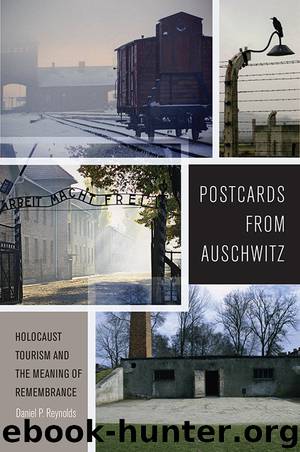Postcards from Auschwitz by Daniel P. Reynolds

Author:Daniel P. Reynolds
Language: eng
Format: epub
Publisher: NYU Press
Figure 4.1. One of the dozens of signs placed by Bayerischer Platz by Renata Stih and Frieder Schnock, August 2014. This sign explains that Jews may sit only on designated benches. Photo by the author.
In September 2014, a new memorial design was unveiled in front of the Philharmonic, just meters away from the plaque and the Serra sculpture. The new memorial is part conceptual design and part education center, consisting of two dark granite half walls parallel to one another in a line running from the northeast to the southwest. The easternmost half wall can serve as a bench, while the westernmost structure is waist high with engraved information and video screens about the euthanasia operations in Germany, documenting the victims, the locations where the killings occurred, and the personnel involved in the killings, many of whom helped develop the techniques for the mass killing of Jews in the East. The granite walls run about forty-two meters in length and are separated by about twelve meters. In between them stands the centerpiece of the memorial, a taller wall of blue glass situated at a diagonal angle from the surrounding granite walls and about half their length. The blue wall is intended to signify the ascent from darkness into the heavens, perhaps also referencing the cremation of the victims’ bodies.45 Visitors will see a scene turned blue as they gaze through the wall, perhaps reflecting the memorial’s intention to remember difference and to invite identification with those who were murdered for theirs. The wall’s skewed angle compared to the surrounding parallel lines may also reinforce the idea of difference, now reimagined as redemptive, aesthetic beauty. There is a dimension of kitsch to this blue wall that seems out of place with the heartless murders conveyed through image and text in the nearby granite. It appears ornamental in relation to the Philharmonic building, repeating the gesture of Serra’s sculpture but in an oddly cheerful manner. Tourists will likely have positive responses to any effort to memorialize the euthanasia program, although what they will make of the blue glass wall remains to be seen. Students with whom I traveled reacted more positively to the new memorial than I did and enjoyed the challenge of decoding the installation’s significance. I wonder, though, whether the task of interpreting the artwork displaces the contemplation of the facts that the installation presents, if for no other reason than because the central artwork has an almost playful tone.
Monumental Countermonuments
While the 1990s saw the continued development of Holocaust memory dispersed throughout the city’s reach, the primary development in the urban memorial landscape has been the establishment of three massive memorials in Berlin’s center: The Topography of Terror, the Jewish Museum, and the Memorial to the Murdered Jews of Europe. Despite their far larger size, each of these memorials is notable as an instantiation of the so-called countermonument, a term that can also be applied to such memorials as disparate as the Stolpersteine, the Places of Remembrance, or even Christo’s Wrapped Reichstag in 1994, all of which reject traditional monumental forms of commemoration.
Download
This site does not store any files on its server. We only index and link to content provided by other sites. Please contact the content providers to delete copyright contents if any and email us, we'll remove relevant links or contents immediately.
Life 3.0: Being Human in the Age of Artificial Intelligence by Tegmark Max(5506)
The Sports Rules Book by Human Kinetics(4339)
The Age of Surveillance Capitalism by Shoshana Zuboff(4242)
ACT Math For Dummies by Zegarelli Mark(4016)
Unlabel: Selling You Without Selling Out by Marc Ecko(3622)
Blood, Sweat, and Pixels by Jason Schreier(3583)
Hidden Persuasion: 33 psychological influence techniques in advertising by Marc Andrews & Matthijs van Leeuwen & Rick van Baaren(3515)
Bad Pharma by Ben Goldacre(3395)
The Pixar Touch by David A. Price(3389)
Urban Outlaw by Magnus Walker(3363)
Project Animal Farm: An Accidental Journey into the Secret World of Farming and the Truth About Our Food by Sonia Faruqi(3189)
Kitchen confidential by Anthony Bourdain(3044)
Brotopia by Emily Chang(3024)
Slugfest by Reed Tucker(2969)
The Content Trap by Bharat Anand(2884)
The Airbnb Story by Leigh Gallagher(2820)
Coffee for One by KJ Fallon(2598)
Smuggler's Cove: Exotic Cocktails, Rum, and the Cult of Tiki by Martin Cate & Rebecca Cate(2493)
Beer is proof God loves us by Charles W. Bamforth(2414)
